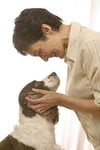
The domestication of dogs from their wild ancestors appears to have occurred during the late Pleistocene period, just 12,000 brief years ago. So it has taken thousands of years for your dog to evolve to the Perfect Pooch that now sits at your feet – but if you look closely, you will still see the wolf within.
Beware the Wolf Within
You will see it when your pup is preparing to sleep. Young wolf pups sleep on top of each other in an untidy ‘doggy pile’ of bodies. This gives them warmth and the comfort of company. The same occurs with modern day pups and I am sure that you found your Perfect Pooch slept more peacefully on those first few nights at home when it was given a water bottle and a ticking clock to mimic its wolf-like needs.
However, as your puppy matures, its sleeping behaviour changes. It will start to circle a few times before settling. This is common and an obvious sign of nest making. It stems from the Pleistocene Pooch’s need to flatten undergrowth and grass to make a soft nesting spot.
When they are not asleep, puppies are usually playing. Watching the rollicking, tumbling play of a litter of pups is not only entertaining but also quite educational. Play behaviour is a trait that we have strengthened through selective breeding because it is a part of dog ownership that we enjoy. Dogs play more than wolves, and, apparently, wolves play more than coyotes.
The Importance of Play
Play behaviour is important. The more a puppy plays, the less likely it is that aggression will appear later in life. Play behaviour begins in pups at three weeks of age and continues in some form until well into adult life. In a wolf litter, pups as young as three-and-a-half weeks can effectively signal to other pups that ‘what follows is play behaviour’. It is vital that play fighting can be distinguished from real fighting and the ‘play bow’ that wolf puppies exhibit is the way they show the difference.
Play is such an important testing ground for future behaviours. When a pup plays, it is often the same as a wolf cub’s play. It will usually start with a play bow, and what follows is a rollicking mixture of pouncing, snapping, running and rolling. In this mayhem, a pup will sometimes stand over a litter-mate, practising the dominant wolf position, and will sometimes roll on its back playing the submissive roll. Testing and learning like this make for contented pups. However, interestingly, although the dominance concept is one that may apply to free-roaming wolves, it is not one that relates at all well to the domestic dog living with humans. Indeed attempting to create behaviour change using the out-dated principles of subordinance and punishment can be quite harmful to dog and mankind.
So for your Perfect Pup, you need to stimulate play but control the outcomes. If your pup gets too ‘mouthy’, it’s best to avoid punishment. Don’t hit the pup. Instead, divert the aggression to a calmer outcome – we use the 5-Second-Laser-Lock-Sit technique. (More information here)
Get the Sit to happen, reward that after 5 seconds and your pup will soonb learn what behaviour gets rewards and which behaviours stop further interaction.
Why does your dog lick you?
Have you noticed that your Perfect Pup attempts to lick your face quite often? I hope you vomit when it does because if you don’t, your Pup could be terribly offended! There’s the Wolf in your pup’s clothing again. During the process of weaning, between four and six weeks of age, wolf puppies use such behaviour to beg for food from their dam. After being licked enthusiastically by the pups, the dam will regurgitate food that she has eaten while hunting. The slurry of partly digested food is easier for the pups to digest and it helps the transition from the dam’s milk to solid food.
Sometimes face licking is also a greeting behaviour. In wolves, the return of the pack after a hunt will be of great significance. The pups will jump up at the returning hunters expressing joy that the pack is reformed but they will also smell their faces during the greeting. This is to determine what has been consumed by the hunter. It is much the same as the behaviour of dogs jumping up on their owners when they return to the ‘home range’ after work. While it is wonderful to receive such greetings, they wear a bit thin when muddy paw prints adorn our expensive business clothes!
Yes – beware the Wolf in your pup’s clothing. Pamper your Perfect Pup but make it work for what it wants. Coach it with gentle obedience training, guide it away from unwanted behaviours and reward those behaviours which are sociable, pleasurable and appropriate. Do that and you will keep the Wolf at bay.

Review questions
- When did the domestication of wolves start – 1200, 12,000 or 120 years ago?
- Why do many dogs circle before lying down?
- Do wolves play as much as coyotes?
- How can play be used to reduce aggression pups?
- Why do dogs lick faces?
